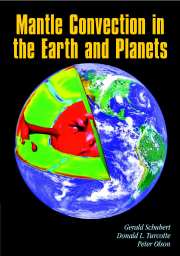Book contents
- Frontmatter
- Contents
- Preface
- 1 Historical Background
- 2 Plate Tectonics
- 3 Structure and Composition of the Mantle
- 4 Mantle Temperatures and Thermodynamic Properties
- 5 Viscosity of the Mantle
- 6 Basic Equations
- 7 Linear Stability
- 8 Approximate Solutions
- 9 Calculations of Convection in Two Dimensions
- 10 Numerical Models of Three-dimensional Convection
- 11 Hot Spots and Mantle Plumes
- 12 Chemical Geodynamics
- 13 Thermal History of the Earth
- 14 Convection in the Interiors of Solid Planets and Moons
- 15 Nature of Convection in the Mantle
- References
- Appendix: Table of Variables
- Author Index
- Subject Index
7 - Linear Stability
Published online by Cambridge University Press: 15 December 2009
- Frontmatter
- Contents
- Preface
- 1 Historical Background
- 2 Plate Tectonics
- 3 Structure and Composition of the Mantle
- 4 Mantle Temperatures and Thermodynamic Properties
- 5 Viscosity of the Mantle
- 6 Basic Equations
- 7 Linear Stability
- 8 Approximate Solutions
- 9 Calculations of Convection in Two Dimensions
- 10 Numerical Models of Three-dimensional Convection
- 11 Hot Spots and Mantle Plumes
- 12 Chemical Geodynamics
- 13 Thermal History of the Earth
- 14 Convection in the Interiors of Solid Planets and Moons
- 15 Nature of Convection in the Mantle
- References
- Appendix: Table of Variables
- Author Index
- Subject Index
Summary
Introduction
In this chapter we will be concerned with the onset of thermal convection when the fluid is heated just enough that weak convective motions begin to take over from conduction or radiation and transfer some of the heat. We will assume that the onset of convection occurs as a bifurcation from a motionless conductive state. We treat the onset of convection as a problem in the stability of the basic motionless state, i.e., we subject the basic state to perturbations of temperature and velocity and determine conditions under which the perturbations decay or amplify. The onset of convection corresponds to the state in which perturbations have zero growth rate.
If perturbations have a negative growth rate, i.e., if they decay, the basic motionless state is stable and heat is transported conductively. If perturbations have a positive growth rate, they amplify and establish a state of motion in which heat is partly transported convectively. We subject the basic state to perturbations of infinitesimal amplitude. In this case the stability problem can be linearized in the sense that quadratic and higher order products of perturbation quantities can be neglected compared to linear order perturbation quantities.
The linear stability or onset of convection problem is a classic problem with a large literature (see, e.g. Chandrasekhar, 1961). Although mantle convection is a highly nonlinear phenomenon, the linearized stability problem is relevant because it is amenable to analytical description and it contains much of the physics of the nonlinear convective state.
Summary of Basic Equations
The basic equations governing the onset of thermal convection are the conservation equations of mass, momentum, and energy discussed in Chapter 6.
- Type
- Chapter
- Information
- Mantle Convection in the Earth and Planets , pp. 288 - 329Publisher: Cambridge University PressPrint publication year: 2001

